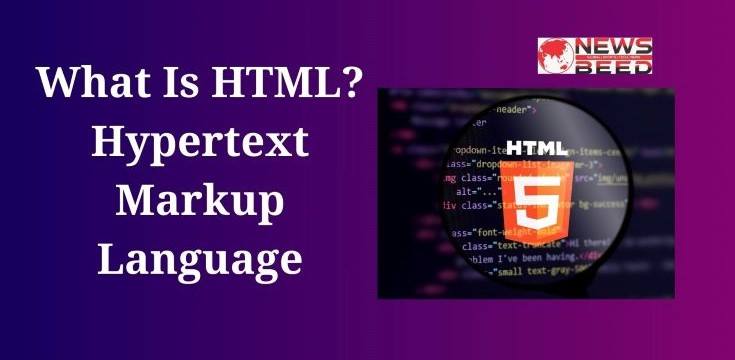Significance of HTML in Web Development
HTML is foundational to web development, serving as the backbone of web content. It works alongside CSS (Cascading Style Sheets) for styling and JavaScript for interactivity, forming the triad of cornerstone technologies for the World Wide Web. Understanding Hypertext Markup Language is essential for web designers and developers, as it enables them to create structured pages and web applications that are accessible across different browsers and devices.
Basic Syntax and Document Structure
An HTML document is made up of elements and tags. Elements are the building blocks of HTML pages, and tags are used to mark up the start and end of an element. Hypertext Markup Language documents begin with a document type declaration, followed by the <html> element, which encloses the head and body of the document. The head section contains meta-information about the document, such as its title and links to stylesheets, while the body section contains the content that is displayed to users.
Core HTML Elements
- Structural elements: Define the structure and outline of a website, including
<header>, <footer>, <nav>, <section>, <article>, and <aside>.
- Text formatting elements: Provide formatting for text, including
<h1> to <h6> for headings, <p> for paragraphs, <strong> for strong emphasis, and <em> for emphasized text.
- List elements: Include ordered (
<ol>) and unordered (<ul>) lists, with <li> representing each item in the list.
- Link and image elements:
<a> is used for hyperlinks, and <img> is used to embed images in a document.
- Form elements: Enable user interaction and data collection, including
<form>, <input>, <textarea>, <button>, and others.
Attributes
Attributes provide additional information about HTML elements. They are placed within the opening tag of an element and consist of a name-value pair. Common attributes include id and class for identifying and classifying elements, src and alt for specifying image sources and alternative text, and href for defining hyperlink references.
HTML5 and Modern Web Development
HTML5 introduced many features that enhanced web development capabilities, including:
- Semantics: New semantic elements provide better document structuring and clarity.
- Multimedia: Elements like
<video> and <audio> simplify multimedia integration.
- Graphics:
<canvas> and inline SVG support enable dynamic graphics and animations.
- Application foundations: Features like local storage, session storage, and application cache improve web application performance and user experience.
Accessibility and SEO
HTML also plays a crucial role in making web content accessible to users with disabilities. Using semantic elements correctly and providing alternative text for images are practices that improve accessibility. Furthermore, well-structured Hypertext Markup Language is critical for search engine optimization (SEO), as it allows search engines to better understand the content and structure of web pages.
Practical Application and Best Practices
When creating web pages or applications, developers should adhere to best practices such as using semantic HTML, ensuring accessibility, validating Hypertext Markup Language code, and keeping the structure clean and organized. Tools like the W3C Hypertext Markup Language Validator can help identify and correct errors in HTML documents.
In practice, creating an HTML document involves defining its structure, adding content, and linking it to CSS and JavaScript files for styling and functionality. Developers must understand the interplay between HTML, CSS, and JavaScript to create dynamic, responsive, and interactive web experiences.
You May Also Read:
What is Digital Marketing in Hindi
What is Digital Marketing
Types of Keywords in SEO
What is Google Search Console
SEO Interview Questions and Answers
What is Technical SEO
What is Affiliate Marketing Meaning
Google Search Console Interview Questions And Answers
Conclusion
HTML is a pivotal technology in the realm of web development, providing the structure and content of web pages. Its evolution from simple document formatting to a powerful tool for creating sophisticated web applications reflects the growing complexity and capabilities of the web. Understanding Hypertext Markup Language, in conjunction with CSS and JavaScript, is essential for anyone looking to build or maintain websites and web applications. As the web continues to evolve, so too will HTML, adapting to new challenges and opportunities to keep the web open, accessible, and vibrant.
This comprehensive overview of HTML encompasses its history, significance, syntax, elements, attributes, and practical applications, offering insights into its role as the backbone of web content. As we continue to push the boundaries of what’s possible on the web, Hypertext Markup Language will remain at the core of our toolkit, enabling creators to structure, link, and enrich our digital experiences.
FAQs:
Q1. What is HTML?
Ans: HTML is a markup language used for creating web pages and web applications. With Cascading Style Sheets (CSS) and JavaScript, it forms a triad of cornerstone technologies for the World Wide Web.
Q. How does HTML work?
Ans: HTML works by marking up text files with tags, which are special instructions that define the structure of a webpage. These tags indicate how different parts of the page should be displayed by web browsers.
Q3. What are HTML tags?
Ans: HTML tags are special instructions enclosed in angle brackets, like <tag>, that define and structure the content of a webpage. Tags can indicate headings, paragraphs, links, images, and more.
Q4. Is HTML a programming language?
Ans: No, HTML is not a programming language; it is a markup language. It structures content on the web but doesn’t have the capability to perform logic or computations like programming languages do.
Q5. What is the difference between HTML and HTML5?
Ans: HTML5 is the latest version of HTML. It introduced new features and elements to help with creating more interactive and multimedia-rich content, such as video, audio, and canvas elements, as well as new form controls.
Q6. Can HTML be used for creating mobile applications?
Ans: Yes, HTML, along with CSS and JavaScript, can be used to create mobile applications. Frameworks like Apache Cordova or tools like PhoneGap wrap HTML-based web applications into a native container that can run on mobile devices.
Q7. What are the basic components of an HTML document?
Ans: The basic components of an HTML document include:
<!DOCTYPE html>: Declares the document type and version of HTML.<html>: The root element that contains the entire Hypertext Markup Language document.<head>: Contains meta-information about the document, like its title and links to CSS files.<body>: Contains the content of the document, such as text, images, and links.
Q8. How can I learn HTML?
Ans: HTML can be learned through online tutorials, courses, and documentation. Websites like W3Schools, MDN Web Docs (by Mozilla), and freeCodeCamp offer extensive resources for beginners to advanced users.
Q9. Is HTML necessary for web development?
Ans: Yes, understanding HTML is fundamental for web development. It’s the basis for creating webpages, and knowledge of Hypertext Markup Language is essential for front-end development, along with CSS and JavaScript.





 #DigitalMarketing #Blogging
#DigitalMarketing #Blogging
I was excited to find this web site. I wanted to thank you for your time for this wonderful read!!
I definitely savored every part of it and I have you book-marked
to check out new stuff on your blog.